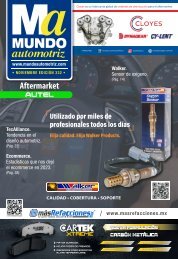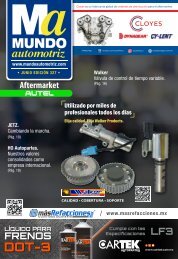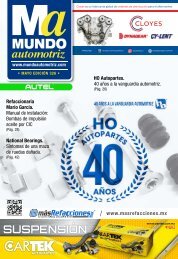Mundo Automotriz La Revista No. 242 Mayo 2016
Los especialistas en Aftermarket
Los especialistas en Aftermarket
You also want an ePaper? Increase the reach of your titles
YUMPU automatically turns print PDFs into web optimized ePapers that Google loves.
ARTÍCULO TÉCNICO<br />
El funcionamiento puede variar<br />
dependiendo del fabricante,<br />
pero el modelo más<br />
general aprovecha la<br />
propia cremallera<br />
como pistón hidráulico<br />
para generar la<br />
asistencia. De esta<br />
forma, cuando el<br />
conductor gira el<br />
volante el sensor<br />
hidráulico permite<br />
el paso del fluido<br />
hacia uno de los<br />
lados del pistón, aumentando<br />
la presión<br />
de ese lado y haciendo<br />
que la cremallera se desplace<br />
axialmente hacia el lado<br />
al que el conductor gira el volante.<br />
Una vez que el conductor deja de girar el volante la presión se<br />
iguala y la cremallera queda en su posición original.<br />
Electro-hidráulica<br />
<strong>La</strong> dirección electro-hidráulica o EHPS (Electro-Hydraulic Powered<br />
Steering) es una evolución de la dirección hidráulica. En<br />
vez de utilizar una bomba hidráulica conectada al motor, utiliza<br />
un motor eléctrico para mover la bomba hidráulica.<br />
Su principal ventaja es que al no estar conectada al motor<br />
del vehículo evita los problemas mecánicos asociados a una<br />
transmisión por correa. Además reduce el consumo de combustible.<br />
En este caso la bomba hidráulica sólo funciona cuando<br />
y al ritmo que se necesita para operar la dirección. <strong>La</strong><br />
alimentación del motor que mueve la bomba se hace a través<br />
de la batería.<br />
Estas ventajas frente a las hidráulicas ha hecho que las direcciones<br />
electro-hidráulicas hayan ido sustituyendo a las hidráulicas<br />
progresivamente.<br />
El funcionamiento de una dirección electro-hidráulica es similar<br />
al de una hidráulica.<br />
Eléctrica<br />
<strong>La</strong>s direcciones eléctricas o EPS (Electrical Powered Steering)<br />
son el tipo más reciente de dirección asistida. Su nombre se<br />
debe a que utilizan un motor eléctrico para generar la asistencia<br />
en la dirección.<br />
kind of vehicles; even though they are being<br />
substituted by the electro-hydraulics and the<br />
electrical. So they are hardly installed in the<br />
new models.<br />
The power steering uses hydraulic energy to<br />
generate the assistance. To do that it uses<br />
a hydraulic pump linked to the engine. The<br />
common is that is coupled directly to the<br />
engine by a belt.<br />
The development may vary depending on<br />
the car manufacturer, but the most popular<br />
model takes advantage its own flywheel as a<br />
piston to generate the assistance. Otherwise,<br />
when the driver steers the steering wheel,<br />
the hydraulic sensor allows to go through the<br />
fluid to one of the piston´s sides, increasing<br />
the pressure on this side and making that<br />
the rack to be displaced axially to where the<br />
driver is steering the steering wheel. Once<br />
the driver stops steering the steering wheel´s<br />
pressure is equalized and the rack gets to its<br />
original position.<br />
Electro-Hydraulic<br />
The Electro-hydraulic Powered Steering is an<br />
evolution of the hydraulic steering. Instead<br />
of using a hydraulic pump connected to the<br />
engine, uses an electric motor to move the<br />
hydraulic pump.Its main advantage is that<br />
it is by being not connected to the vehicle´s<br />
engine avoids the mechanical problems associated<br />
to the belt´s transmissions. Besides,<br />
it reduces the fuel consumption. In this case,<br />
the hydraulic pump functions only when<br />
and to the rhythm that is required to do the<br />
steering work. The feeding of the engine that<br />
moves the pump is done through the battery.<br />
These advantages, compared to the hydraulics<br />
have made that the electro-hydraulic<br />
steering have been replacing, progressively,<br />
the hydraulic ones.<br />
The functioning of one electro-hydraulic<br />
steering is similar to the hydraulic one.<br />
Electric<br />
The Electrical Powered Steering is the most<br />
recent powered steering. Its name is due that<br />
they use an electric motor to generate the assistance<br />
to the steering.<br />
Its advantage, compared to the hydraulic<br />
and the electro-hydraulic is that they do not<br />
use hydraulic energy, they are lighter and<br />
simpler due to the elimination of its installation<br />
and of the hydraulic pumps, that also<br />
helps to reduce the weight of the vehicle.<br />
72<br />
Síguenos en Facebook: <strong>Revista</strong> <strong>Mundo</strong> <strong>Automotriz</strong>

















